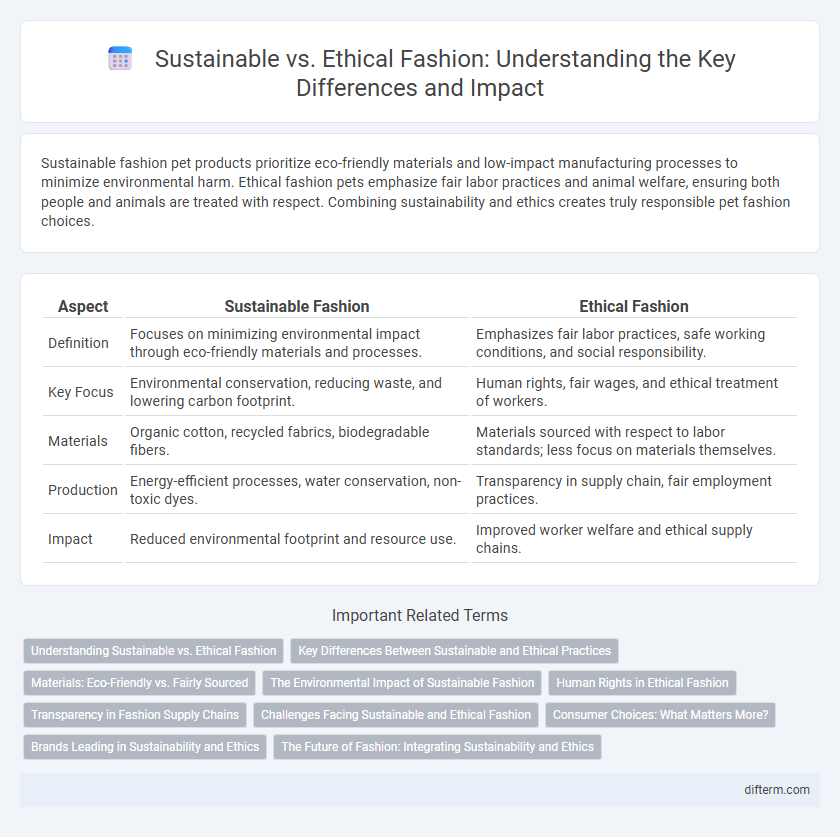Sustainable fashion pet products prioritize eco-friendly materials and low-impact manufacturing processes to minimize environmental harm. Ethical fashion pets emphasize fair labor practices and animal welfare, ensuring both people and animals are treated with respect. Combining sustainability and ethics creates truly responsible pet fashion choices.
Table of Comparison
| Aspect | Sustainable Fashion | Ethical Fashion |
|---|---|---|
| Definition | Focuses on minimizing environmental impact through eco-friendly materials and processes. | Emphasizes fair labor practices, safe working conditions, and social responsibility. |
| Key Focus | Environmental conservation, reducing waste, and lowering carbon footprint. | Human rights, fair wages, and ethical treatment of workers. |
| Materials | Organic cotton, recycled fabrics, biodegradable fibers. | Materials sourced with respect to labor standards; less focus on materials themselves. |
| Production | Energy-efficient processes, water conservation, non-toxic dyes. | Transparency in supply chain, fair employment practices. |
| Impact | Reduced environmental footprint and resource use. | Improved worker welfare and ethical supply chains. |
Understanding Sustainable vs. Ethical Fashion
Sustainable fashion focuses on minimizing environmental impact through eco-friendly materials, waste reduction, and energy-efficient production processes. Ethical fashion emphasizes fair labor practices, safe working conditions, and equitable wages for workers throughout the supply chain. Understanding these distinctions helps consumers make informed choices that support both planet-friendly and socially responsible apparel.
Key Differences Between Sustainable and Ethical Practices
Sustainable fashion focuses on minimizing environmental impact through resource efficiency, biodegradable materials, and reducing waste, while ethical fashion prioritizes fair labor practices, safe working conditions, and equitable wages for workers. Sustainable practices often include using organic fabrics, water conservation, and reducing carbon footprints, whereas ethical practices ensure transparency in the supply chain and respect for human rights. Both approaches aim to transform the fashion industry but address different critical aspects of social and environmental responsibility.
Materials: Eco-Friendly vs. Fairly Sourced
Sustainable fashion emphasizes the use of eco-friendly materials such as organic cotton, recycled polyester, and bamboo, which reduce environmental impact through lower water usage and carbon emissions. Ethical fashion prioritizes fairly sourced materials ensuring fair labor practices, safe working conditions, and fair wages for producers throughout the supply chain. Brands focused on sustainability often combine eco-friendly materials with ethical sourcing to promote both environmental responsibility and social equity in fashion production.
The Environmental Impact of Sustainable Fashion
Sustainable fashion prioritizes reducing waste, conserving resources, and minimizing carbon emissions by using organic materials, recycling fabrics, and adopting eco-friendly production methods. The environmental impact includes lower water consumption and reduced pollution compared to conventional fashion practices. Ethical considerations often overlap but focus more on fair labor practices rather than solely on ecological footprint.
Human Rights in Ethical Fashion
Ethical fashion prioritizes human rights by ensuring fair wages, safe working conditions, and the elimination of child labor throughout the supply chain. Sustainable fashion focuses more broadly on environmental impact, such as reducing waste and using eco-friendly materials, but may not always address labor practices. Brands committed to ethical fashion integrate comprehensive human rights standards to protect garment workers worldwide, promoting dignity and social justice alongside environmental responsibility.
Transparency in Fashion Supply Chains
Transparency in fashion supply chains reveals the critical differences between sustainable and ethical practices by exposing the environmental impact, labor conditions, and sourcing origins of materials. Brands committed to transparency provide detailed audits and traceability, enabling consumers to make informed choices that support responsible production. Enhanced visibility fosters accountability, driving the industry toward more sustainable resource management and ethical labor standards.
Challenges Facing Sustainable and Ethical Fashion
Sustainable fashion faces challenges such as sourcing eco-friendly materials that balance quality with environmental impact, alongside managing supply chains to reduce carbon footprints without inflating costs. Ethical fashion struggles with ensuring fair labor practices and transparency across global production networks, often hindered by inconsistent regulations and limited oversight. Both sectors contend with consumer awareness gaps, making it difficult to shift demand toward truly sustainable and ethically-produced apparel.
Consumer Choices: What Matters More?
Consumer choices in fashion increasingly prioritize sustainability by focusing on eco-friendly materials, reduced carbon footprints, and waste minimization to address environmental impact. Ethical fashion emphasizes fair labor practices, safe working conditions, and equitable wages, ensuring social responsibility throughout the supply chain. Balancing sustainability and ethics proves crucial as consumers demand transparency and accountability to support brands aligning with both environmental and social values.
Brands Leading in Sustainability and Ethics
Brands leading in sustainability and ethics, such as Patagonia, Stella McCartney, and Eileen Fisher, prioritize eco-friendly materials and fair labor practices to reduce environmental impact and promote social responsibility. These companies implement transparent supply chains, utilize organic and recycled fabrics, and support workers' rights, setting benchmarks for the fashion industry. Their commitment fosters consumer trust and drives a global movement towards more sustainable and ethical fashion production.
The Future of Fashion: Integrating Sustainability and Ethics
Sustainable fashion emphasizes minimizing environmental impact through eco-friendly materials and production processes, while ethical fashion prioritizes fair labor practices and social responsibility. Integrating both approaches drives the future of fashion by fostering transparent supply chains and circular economy models that reduce waste and promote workers' rights. Brands investing in sustainable and ethical innovations are shaping a resilient industry aligned with consumer demand for accountability and long-term global stewardship.
sustainable vs ethical Infographic

 difterm.com
difterm.com